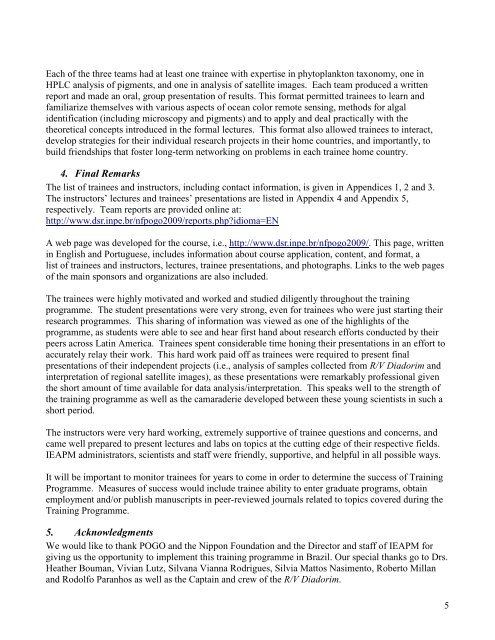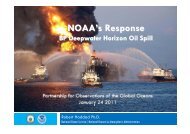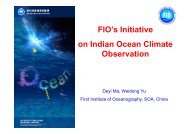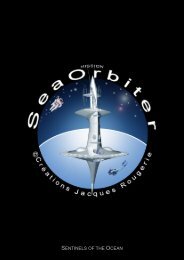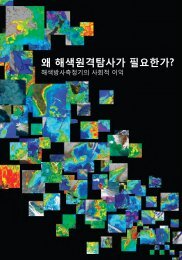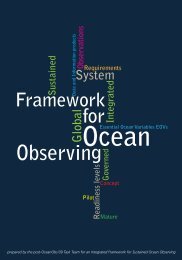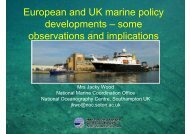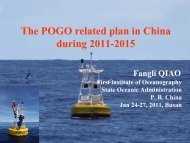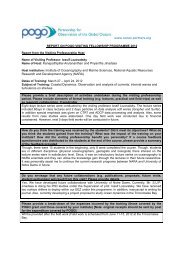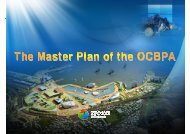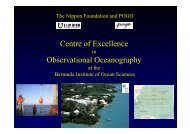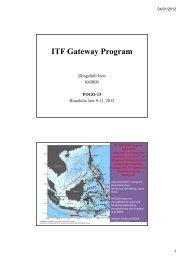NF-POGO Centre of Excellence Year 2 Report
NF-POGO Centre of Excellence Year 2 Report
NF-POGO Centre of Excellence Year 2 Report
- No tags were found...
You also want an ePaper? Increase the reach of your titles
YUMPU automatically turns print PDFs into web optimized ePapers that Google loves.
Each <strong>of</strong> the three teams had at least one trainee with expertise in phytoplankton taxonomy, one inHPLC analysis <strong>of</strong> pigments, and one in analysis <strong>of</strong> satellite images. Each team produced a writtenreport and made an oral, group presentation <strong>of</strong> results. This format permitted trainees to learn andfamiliarize themselves with various aspects <strong>of</strong> ocean color remote sensing, methods for algalidentification (including microscopy and pigments) and to apply and deal practically with thetheoretical concepts introduced in the formal lectures. This format also allowed trainees to interact,develop strategies for their individual research projects in their home countries, and importantly, tobuild friendships that foster long-term networking on problems in each trainee home country.4. Final RemarksThe list <strong>of</strong> trainees and instructors, including contact information, is given in Appendices 1, 2 and 3.The instructors’ lectures and trainees’ presentations are listed in Appendix 4 and Appendix 5,respectively. Team reports are provided online at:http://www.dsr.inpe.br/nfpogo2009/reports.php?idioma=ENA web page was developed for the course, i.e., http://www.dsr.inpe.br/nfpogo2009/. This page, writtenin English and Portuguese, includes information about course application, content, and format, alist <strong>of</strong> trainees and instructors, lectures, trainee presentations, and photographs. Links to the web pages<strong>of</strong> the main sponsors and organizations are also included.The trainees were highly motivated and worked and studied diligently throughout the trainingprogramme. The student presentations were very strong, even for trainees who were just starting theirresearch programmes. This sharing <strong>of</strong> information was viewed as one <strong>of</strong> the highlights <strong>of</strong> theprogramme, as students were able to see and hear first hand about research efforts conducted by theirpeers across Latin America. Trainees spent considerable time honing their presentations in an effort toaccurately relay their work. This hard work paid <strong>of</strong>f as trainees were required to present finalpresentations <strong>of</strong> their independent projects (i.e., analysis <strong>of</strong> samples collected from R/V Diadorim andinterpretation <strong>of</strong> regional satellite images), as these presentations were remarkably pr<strong>of</strong>essional giventhe short amount <strong>of</strong> time available for data analysis/interpretation. This speaks well to the strength <strong>of</strong>the training programme as well as the camaraderie developed between these young scientists in such ashort period.The instructors were very hard working, extremely supportive <strong>of</strong> trainee questions and concerns, andcame well prepared to present lectures and labs on topics at the cutting edge <strong>of</strong> their respective fields.IEAPM administrators, scientists and staff were friendly, supportive, and helpful in all possible ways.It will be important to monitor trainees for years to come in order to determine the success <strong>of</strong> TrainingProgramme. Measures <strong>of</strong> success would include trainee ability to enter graduate programs, obtainemployment and/or publish manuscripts in peer-reviewed journals related to topics covered during theTraining Programme.5. AcknowledgmentsWe would like to thank <strong>POGO</strong> and the Nippon Foundation and the Director and staff <strong>of</strong> IEAPM forgiving us the opportunity to implement this training programme in Brazil. Our special thanks go to Drs.Heather Bouman, Vivian Lutz, Silvana Vianna Rodrigues, Silvia Mattos Nasimento, Roberto Millanand Rodolfo Paranhos as well as the Captain and crew <strong>of</strong> the R/V Diadorim.5


